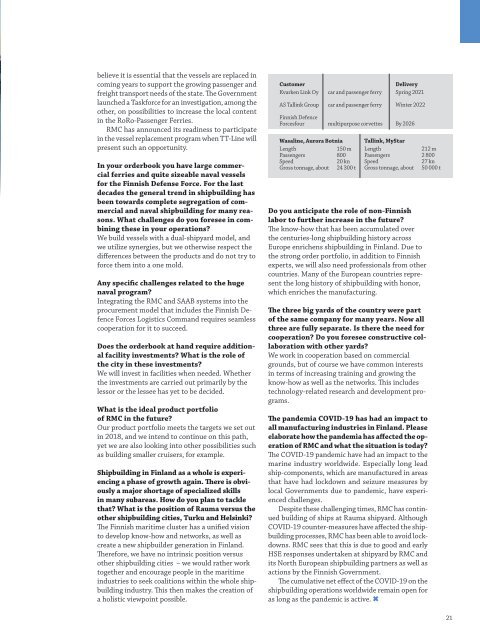Create successful ePaper yourself
Turn your PDF publications into a flip-book with our unique Google optimized e-Paper software.
elieve it is essential that the vessels are replaced in<br />
coming years to support the growing passenger and<br />
freight transport needs of the state. The Government<br />
launched a Taskforce for an investigation, among the<br />
other, on possibilities to increase the local content<br />
in the RoRo-Passenger Ferries.<br />
RMC has announced its readiness to participate<br />
in the vessel replacement program when TT-Line will<br />
present such an opportunity.<br />
In your orderbook you have large commercial<br />
ferries and quite sizeable naval vessels<br />
for the <strong>Finnish</strong> Defense Force. For the last<br />
decades the general trend in shipbuilding has<br />
been towards complete segregation of commercial<br />
and naval shipbuilding for many reasons.<br />
What challenges do you foresee in combining<br />
these in your operations?<br />
We build vessels with a dual-shipyard model, and<br />
we utilize synergies, but we otherwise respect the<br />
differences between the products and do not try to<br />
force them into a one mold.<br />
Any specific challenges related to the huge<br />
naval program?<br />
Integrating the RMC and SAAB systems into the<br />
procurement model that includes the <strong>Finnish</strong> Defence<br />
Forces Logistics Command requires seamless<br />
cooperation for it to succeed.<br />
Does the orderbook at hand require additional<br />
facility investments? What is the role of<br />
the city in these investments?<br />
We will invest in facilities when needed. Whether<br />
the investments are carried out primarily by the<br />
lessor or the lessee has yet to be decided.<br />
What is the ideal product portfolio<br />
of RMC in the future?<br />
Our product portfolio meets the targets we set out<br />
in 2018, and we intend to continue on this path,<br />
yet we are also looking into other possibilities such<br />
as building smaller cruisers, for example.<br />
Shipbuilding in Finland as a whole is experiencing<br />
a phase of growth again. There is obviously<br />
a major shortage of specialized skills<br />
in many subareas. How do you plan to tackle<br />
that? What is the position of Rauma versus the<br />
other shipbuilding cities, Turku and Helsinki?<br />
The <strong>Finnish</strong> maritime cluster has a unified vision<br />
to develop know-how and networks, as well as<br />
create a new shipbuilder generation in Finland.<br />
Therefore, we have no intrinsic position versus<br />
other shipbuilding cities – we would rather work<br />
together and encourage people in the maritime<br />
industries to seek coalitions within the whole shipbuilding<br />
industry. This then makes the creation of<br />
a holistic viewpoint possible.<br />
Customer<br />
Delivery<br />
Kvarken Link Oy car and passenger ferry Spring <strong>2021</strong><br />
AS Tallink Group car and passenger ferry Winter 2022<br />
<strong>Finnish</strong> Defence<br />
Forcesfour multipurpose corvettes By 2026<br />
Wasaline, Aurora Botnia<br />
Length<br />
150 m<br />
Passengers 800<br />
Speed<br />
20 kn<br />
Gross tonnage, about 24 300 t<br />
Tallink, MyStar<br />
Length<br />
212 m<br />
Passengers 2 800<br />
Speed<br />
27 kn<br />
Gross tonnage, about 50 000 t<br />
Do you anticipate the role of non-<strong>Finnish</strong><br />
labor to further increase in the future?<br />
The know-how that has been accumulated over<br />
the centuries-long shipbuilding history across<br />
Europe enrichens shipbuilding in Finland. Due to<br />
the strong order portfolio, in addition to <strong>Finnish</strong><br />
experts, we will also need professionals from other<br />
countries. Many of the European countries represent<br />
the long history of shipbuilding with honor,<br />
which enriches the manufacturing.<br />
The three big yards of the country were part<br />
of the same company for many years. Now all<br />
three are fully separate. Is there the need for<br />
cooperation? Do you foresee constructive collaboration<br />
with other yards?<br />
We work in cooperation based on commercial<br />
grounds, but of course we have common interests<br />
in terms of increasing training and growing the<br />
know-how as well as the networks. This includes<br />
technology-related research and development programs.<br />
The pandemia COVID-19 has had an impact to<br />
all manufacturing industries in Finland. Please<br />
elaborate how the pandemia has affected the operation<br />
of RMC and what the situation is today?<br />
The COVID-19 pandemic have had an impact to the<br />
marine industry worldwide. Especially long lead<br />
ship-components, which are manufactured in areas<br />
that have had lockdown and seizure measures by<br />
local Governments due to pandemic, have experienced<br />
challenges.<br />
Despite these challenging times, RMC has continued<br />
building of ships at Rauma shipyard. Although<br />
COVID-19 counter-measures have affected the shipbuilding<br />
processes, RMC has been able to avoid lockdowns.<br />
RMC sees that this is due to good and early<br />
HSE responses undertaken at shipyard by RMC and<br />
its North European shipbuilding partners as well as<br />
actions by the <strong>Finnish</strong> Government.<br />
The cumulative net effect of the COVID-19 on the<br />
shipbuilding operations worldwide remain open for<br />
as long as the pandemic is active. ✖<br />
21

















